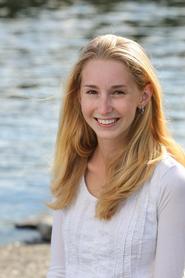
While thousands of scientific articles are published annually, relatively few attract the attention of the general public. The gap between what is understood by scientists and what is common knowledge to the public is the focus of a research project being undertaken by Mary Langworthy ’17 under the advisement of the director of Hamilton’s new Academic Program in the Adirondacks Janelle Schwartz.
Langworthy’s project, titled “Where Geology Meets Literature: A Spatiotemporal Analysis of Science Writing,” is funded through the Emerson Summer Collaborative Research program, which provides grants primarily to student pursuing “research or other scholarly or creative collaboration outside the confines of the classroom" in fields and departments with limited available summer funding.
“This summer, I’m exploring science writing: what makes it successful at informing the public, and how and why shortfalls occur,” explained Langworthy. She will be researching both primary scientific literature and popular science writing relevant to a specific climate issue in each of three locations: the Adirondack Park, Iceland and California. Iceland, in particular was selected due to Langworthy’s upcoming involvement with Professor of Geosciences Barbara Tewksbury’s July geology trip to the volcanically and geologically active island nation.
In a time when environmental science, in particular, finds itself in the news as the perpetual subject of political debate, the clear and accurate relaying of scientific information to the public is of vital importance. Langworthy said she expects that in each of her three areas of study she would find some discrepancy between the scientific community's understanding of the given issue and the general public’s.
However, she claims that different factors likely contribute to said discrepancy across the three different locations. By “identifying and addressing the factors that limit or impede the public’s scientific literacy,” Langworthy hopes to develop accessible new methods of writing about scientific issues that can effectively communicate new ideas to the public, potentially tailored to each geographic location.
Langworthy’s literary research has covered numerous disciplines, ranging from fairly standard sources such as census datum and government documents, to relatively obscure editorials dating back as far as the 1800s, and millennium-old Icelandic sagas. “I have always been interested in writing,” she said, “and this project seemed like a perfect way to integrate my newfound passion for geology with my lifelong fascination with writing.”
Langworthy likens the public to the last member of a group playing the game “telephone,” with regard to scientific issues, claiming that much of the information that reaches the masses suffers from distillation, lack of context and overall poor delivery.
She concluded, “I think that we become accustomed to taking things at face value, and this project has been an exciting opportunity to snoop around in the scientific literature myself and propose how science writing can be made more effective.”
 Read more
Read more 